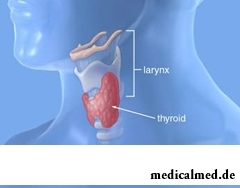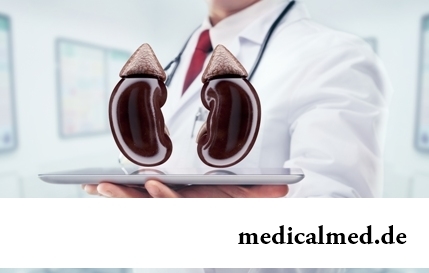





Local craw
General characteristic of a disease

The local craw is the increase in the sizes of a thyroid gland caused by an iodine deficiency in an organism.
As the reason of iodic insufficiency unbalanced food – insufficient consumption of fish, meat, a laminaria, shrimps, dairy products, oat and buckwheat grain, etc. can serve. About 90% of daily need for iodine of people receive exactly thanks to food.
Other possible reason of emergence of a local craw - the gastrointestinal diseases leading to bad absorption of microelements of iodine. At pathologies of intestines or stomach development of a local craw with full or partial iodic insufficiency is possible even if the diet of the patient is rich with the food stuffs containing iodine.
About 5% are made by the daily dose of iodine received by the person at the expense of water. As much again he receives thanks to the air sated with iodine microelements.
There are regions with the small content of iodine in the environment and, respectively, with high risk of development of a local craw. The midland of Russia inclusive with Moscow, for example, concerns to those. The iodine deficiency is observed also in areas with the raised background radiation.
Emergence of a local craw can sometimes provoke systematic reception of the medicines blocking digestion of iodine. Perchlorate, the Lity carry a carbonate, Nitrates, Streptocides to those Potassium, etc.
Also genetic predisposition to development of a local craw at genetic defect of production of thyroid hormones is possible.
Symptoms of a local craw
Increase (hyperplasia) in a thyroid gland at a local craw is a reaction of an organism to low concentration of iodine and the deficit of thyroid hormones caused by it. Quite often in parallel with a local craw the associated disease – a hypothyroidism develops.
Increasing the mass of a thyroid gland, the organism tries to compensate deficit of thyroid hormones, and it leads to emergence of the following symptoms of a local craw:
- weakness,
- small physical endurance,
- discomfort in heart,
- headache.
These symptoms of a local craw can be shown even at a subclinical stage of a disease with sizes of a thyroid gland within norm and at almost not changed level of thyroid hormones.
With the further growth of a thyroid gland new symptoms of a local craw appear:

- feeling of squeezing in area of a neck,
- the complicated swallowing and breath,
- dry cough,
- suffocation attacks.
Symptoms of a local craw of the heaviest stage are heart pathologies – the so-called development of goitrous heart expressed in expansion and hyperfunction of the right auricle and a ventricle.
Among possible complications of a local craw call hemorrhage of a thyroid gland, acute and subacute thyroidites, malignant regeneration of a nodal form of a disease.
Diagnosis of a local craw
In diagnosis of a local craw laboratory blood tests and urine are applied. The patient's blood with clinical symptoms of a local craw is checked for the level of TTG hormones, T3, T4, and also thyreoglobulin.
At patients with this type of a disease the balance of thyroid hormones is usually broken and the increased concentration of thyreoglobulin is observed. Indicators of releases of iodine in urine are, as a rule, reduced.
Tool diagnostic method of a local craw is ultrasonography. Thanks to it the disease form is established: diffusion or nodal local craw. By means of radio isotope scanning of a thyroid gland the functional condition of body is estimated.
At a nodal form of a local craw the biopsy of a thyroid gland is in addition applied to definition of the high-quality or malignant nature of a disease.
Treatment of a local craw
Tactics of treatment of a local craw depends on degree of a hyperplasia of a thyroid gland. At insignificant increase in the sizes of body there are often enough several rates of Potassium iodide. An obligatory part of treatment of a local craw of the I degree is also the dietotherapy the products rich with iodine.
Treatment of the local craw complicated by a hypothyroidism assumes purpose of replacement hormonal therapy. Levotiroksin is considered an artificial analog of hormones of a thyroid gland.
Treatment of a local craw of a nodal form at a late stage of a disease preferential surgical. For prevention of a recurrence of a hyperplasia of a thyroid gland in the postoperative period to the patient replacement hormonal therapy is carried out.
Prevention of a local craw
Effective prevention of development of a local craw is regular consumption of table iodized salt. It is extremely important to add salt to food after its preparation as microelements of iodine collapse heatings in time.
Also regular consumption of seafood, walnuts, persimmon allows to reduce probability of emergence of a local craw. Shall be present at a diet a fish dish and other products rich with iodine.
Local craw at children

Local craw at children – the most widespread iodine deficiency disease. Most often the diffusion form of a disease meets. According to statistical data over the last 10 years the frequency of occurrence of a local craw at children increased by 6% and makes about 25% of all children's endocrinological diseases today.
Such high rates of incidence are explained by the broken character of food and an adverse ecological situation. In a third of cases the local craw was diagnosed for children at teenage age (14 years and are more senior).
Characteristic symptoms of a local craw at children have more intensive expressiveness. Besides, at children's age the disease most often is complicated by development of local cretinism: delay of intellectual and physical development, frustration of TsNS.
Due to the high prevalence of a disease and serious consequences of a local craw at children prevention of a yododefitsit is recommended to be carried out, since pregnancy of mother and to continue during all life of the child.
Stomatologists appeared relatively recently. In the 19th century to pull out painful teeth belonged to duties of the ordinary hairdresser.

The hysteromyoma is diagnosed more than at a third of women 35 years are more senior. This high-quality new growth, which on early a stage...
Section: Articles about health
Kidneys perform the most important function of clarification of blood from those products of metabolic processes which cannot be used by an organism for obtaining energy and construction of new cells. With the urine produced by kidneys from a body of the person bulk is removed...
Section: Articles about health
From sexual contacts each person can test insufficiently strongly expressed sexual desire or lack of satisfaction from time to time. However when it happens regularly, it is an occasion to think about health. Most of people does not hurry to ask similar questions physicians: one consider that they will be able to cope with malfunctions independently, others hesitate to report to strangers about so delicate problems and hope that troubles will stop by itself....
Section: Articles about health
Coffee - the tonic loved by many for the invigorating aroma and deep taste. Having the stimulating effect, coffee raises ра...
Section: Articles about health
So, you resolved to lose weight. And now you try to understand what to begin with: from exercise stresses or a diet? And how to make that process of weight loss did not give you an inconvenience, and, on the contrary, brought joy?...
Section: Slideshow
Herpes simplex of the first type (the infectious disease which is shown periodic bubble rashes on lips is called) – one of the most widespread illnesses. Statistically, only 5% of inhabitants of our planet are unreceptive to its activator, and the reasons of this feature are still not found out. Other people are virus carriers....
Section: Articles about health
The depression not without reason is considered one their main troubles of our century: for scientific and technical progress, acceleration of rate of life and a surplus...
Section: Articles about health
People know that thermal sources have salutary force long ago. Treatment by natural waters is one of the most ancient methods of disposal of the most different diseases. Bathtubs, souls, wrappings and inhalations, in combination with reception of water vnut...
Section: Articles about health
Good appetite was always considered as a sign of good health. The correct operation of the mechanism which is responsible for the need for nutrients and receiving pleasure from process of its satisfaction demonstrates that the organism functions without special deviations. On the other hand, appetite of the person is not a constant. It depends on the culture of food, flavoring addictions imparted since the childhood which can change during life, weather, mood and many д more than once...
Section: Articles about health
Each person supports all life a SARS about 200 times. The peak of incidence falls on cold season, but to get sick from temperatures...
Section: Articles about health
The endocrine system carries out extremely important role in a human body, practically all processes of life activity are regulated by it. Closed glands (hemadens) produce special biologically active agents – hormones which then o...
Section: Articles about health
Any of us is not insured from a heavy illness of the loved one. Happens and so that someone from family members becomes the bed patient, and remains in such state for a long time. It extremely suppresses both the most injured, and all its house which life considerably changes....
Section: Articles about health
Household skills which to us so diligently imparted in the childhood it appears, not always bring only benefit. According to result...
Section: Articles about health
Iodine - one of thirty most important microelements in our organism. The main role of iodine consists in synthesis of thyroid hormones of a thyroid gland - the substances which are responsible for the majority of exchange processes of an organism. It is known that thyroid hormones consist...
Section: Articles about health
For the city dweller the fitness is the most convenient sport. It is enough to acquire the subscription to the gym to get access to various apparatuses and an opportunity to train under the leadership of the experienced consultant. Many consider fitness the best way of maintenance of physical shape and receiving dynamic loads which the people occupied preferential with brainwork so need. Nevertheless, representations of most of consumers of similar services about специф...
Section: Articles about health
Eyes – unique body on the structure thanks to which the person obtains about 80% of information on the world around: about a form...
Section: Articles about health
For most of the working people the problem of having a snack is particularly acute enough. Sooner or later there is a question: what can be eaten quickly between a breakfast and a lunch or a lunch and leaving from service so that to receive necessary power feed, but not an overload...
Section: Articles about health
Subfebrile temperature call fervescence to 38 degrees, and subfebrile condition - existence of such temperature over 3 days, and quite often it happens without the visible reasons. Existence of subfebrile condition - a strong indication of disturbances in an organism which can be caused by various reasons: disease, stresses, hormonal failures. Despite the seeming inoffensiveness it is a state at which people often continue to lead a usual life, often is a sign of many of a zabolev...
Section: Articles about health
One of the major chemical processes happening in a human body are oxidation reactions. They go with participation of fats...
Section: Articles about health
All the known slogan "Protect Men!" arose not from scratch. In a sense, the nature created men much less adapted for vital disorders, than it seems at first sight. Statistically, men are ill more often...
Section: Articles about health
Since the moment when the child becomes a school student, his sight begins to be exposed to the strengthened loadings which are supplemented with viewing of animated films and long computer games. During this period of life of the child development of not completely created organs of sight, it is very easy to break the excessive loading which is aggravated with lack of a work-rest schedule. As a rule, and occurs: according to WHO statistics, every fourth child of school age has these or those diseases of eyes, Wednesday...
Section: Articles about health
80% of women at least once to lives complained of discomfortable feelings to breasts, consolidations and nagrubaniye. These are mastopathy symptoms. Mas...
Section: Articles about health
Water with a lemon - idle time in preparation drink which supporters of a healthy lifestyle already managed to appreciate. Used in a warm look and on an empty stomach, it is one of the most useful prophylactics allowing to prevent tens з...
Section: Articles about health
Frosty air, fresh wind and easy snowball at most of Russians are associated with cheerfulness, health and cheerful entertainments on which our winter is so generous. But, unfortunately, cold season sometimes brings also troubles with health. It is not about seasonal colds and frostbites, and about those chronic illnesses which symptoms are shown preferential in the winter....
Section: Articles about health
Extracorporal fertilization – one of the most modern methods of controlling with infertility. So far it already helped znach...
Section: Articles about health
Hemorrhoids – extremely widespread disease. Periodically arising inflammations and bleeding of hemorrhoidal nodes cause serious discomfort to nearly fifteen percent of adults. Meanwhile, having a clear idea of the aggravation reasons...
Section: Articles about health
Small appetite at the child – the complaint which pediatricians should hear practically from each mother. Most often it is carried to the category of children's whims, however the refusal of food in certain cases can be to alarming symptoms therefore it cannot be ignored....
Section: Articles about health
